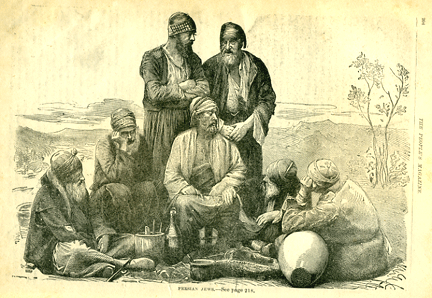
Illustration of “Persian Jews” from the People’s Magazine, 1879
The current fighting in Gaza is a tragedy of Greek dramatic proportions. On the one hand a highly sophisticated military machine wielded at present with Hawkish intent, on the other a ragtag guerilla group bent on lobbing barbs at the Hawk’s fortified lair. And in the middle frightened civilians in a humanitarian nightmare of medieval mindset. The problem is that neither side is really willing to treat the other with consideration and respect. In this unethical tie, of course, the onus must be on the stronger to recognize the limited options of the weaker.
The tragedy does not end with the present loss of life, limb and hope for Gazans. Unfortunately, it overshadows a historical trajectory that created the rise of Zionism as a political ideal in Europe. There is no excuse for the present punishing policies of Israel towards the residents of Gaza. Indeed, it is all the sadder given the sordid history of anti-Semitism in both the Christian-dominated West and Islamic-dominated Near East. Recently I picked up an old magazine from 1879, published exactly 140 years ago. On one page I was struck by the extraordinary pathos of an image of “Persian Jews.” Accompaning the text was a brief commentary about the persecution of Jews in Persia at the time. Yet even in acknowledging their plight, the stereotype of greedy beggars always on the make for more shekels spins the tale for the Victorian Era reader, not to mention the mention of Disraeli, the British Prime Minister whose Jewish roots were inevitably entangled around his political persona.
The excerpt below is worth pondering, not literally, but as a metaphor for the perpetual stigmatizing associated with Semitic labels. It is now 140 years after this was written, but even so the hope appears still dim that one day the persecuted group (fill in the blank as contemporary history dictates) will be “entitlted to consideration and respect.”
Persian Jews
In whatever land the Jews find their local habitation, they exhibit their local habitation, they exhibit the characteristics featured of their race. There is, however, an Orientalism about them that assimilates well with the picturesqueness of Asiatic costume and character. The group represented in our engraving are evidently wanderers in the land of the Shah, under the ban of some Persian Prince, and flying from persecution to the desert. There is weariness and wistfulness in the expression of their eyes and in their attitudes, which lack not, however, a barbaric dignity, as if, even in their vagabondage, they felt themselves heritors of something of the grandeur of ancient Judea. They have just finished their frugal noonday repast, and are consulting, perhaps, whither they shall wend their way to be free from the malice of their enemies; or, perhaps, listening to some legend of their tribe that their chief recounts; or, more likely, revolving in their minds some scheme for the enlargement of their store of shekels.
Tribes of the wandering foot and weary breast.
How shall ye flee away and be at rest!
The wild dove hath her nest, the fox his cave,
Mankind their country – and Israel the grave!But, then, Disraeli has Cyprus; and the time is at hand, no doubt, when even in Persia the Jewish gabardine shall be entitled to consideration and respect.
Excerpt from The People’s Magazine, New York, May, 1879, Vol. II, No. 4, p. 218